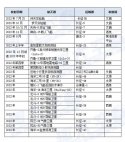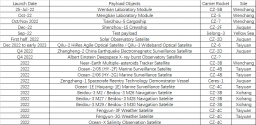You are using an out of date browser. It may not display this or other websites correctly.
You should upgrade or use an alternative browser.
You should upgrade or use an alternative browser.
China's Space Program News Thread
- Thread starter crazyinsane105
- Start date
- Status
- Not open for further replies.
by78
General
Three words: nuclear Neptune orbiter
Chinese planetary scientists and engineers are setting their sights on the outer Solar System and proposing major technological leaps to make it happen..
More on the nuclear orbiter:
Exspace raises $237M:
A one year lag in foreign press coverage.
by78
General
A fun fact: South Korea will be using a deep-space tracking and control system imported from China for its upcoming . The system features a dish antenna 35-meter in diameter that weighs 100 metric tons. It was under and will be used to track and control the lunar orbiter. Also interesting is that the orbiter will be launched using a Space-X Falcon-9 rocket, so this is a true multinational mission.
The first two images below show the imported reflector antenna installed in Yeoju, South Korea. The last three images show the same systems installed at a Chinese tracking facility for China's Chang'E lunar missions.
South Korean tracking facility:


Chinese tracking facility:



The first two images below show the imported reflector antenna installed in Yeoju, South Korea. The last three images show the same systems installed at a Chinese tracking facility for China's Chang'E lunar missions.
South Korean tracking facility:


Chinese tracking facility:



Last edited:
escobar
Brigadier
Chang Guang Satellite Technology Company also selling 30cm imagery!!
As of June 29, 2022, the Tianwen-1 orbiter mission has been in orbit continuously for 706 days, and has obtained medium resolution image data covering the whole planet of Mars. All scientific payloads have realized their global exploration of Mars. Both the Tianwen-1 orbiter and the Zhurong Mars rover have completed the established scientific exploration missions.天问一号完成既定科学探测任务
中国探月工程 2022-06-29 11:59 发表于北京
截至2022年6月29日,天问一号任务环绕器正常飞行706天,获取了覆盖火星全球的中分辨率影像数据,各科学载荷均实现火星全球探测。天问一号任务环绕器和火星车均完成既定科学探测任务。
天问一号任务于2016年1月经党中央批准立项,2020年7月23日成功发射。探测器经过202天4.75亿千米的深空飞行,于2021年2月10日与火星交会,成功实施捕获制动进入环绕火星轨道。对预选着陆区进行了3个月的详查后,于2021年5月15日成功实施火星着陆。5月22日,“祝融号”火星车成功驶上火星表面,开始巡视探测。
2021年8月15日,“祝融号”火星车顺利完成90个火星日既定科学探测任务,继续实施拓展探测任务,已累计在火星表面行驶1921.5米。受着陆区冬季严寒和沙尘天气影响,火星车按设计状态于2022年5月18日进入冬季休眠模式,2022年12月前后,“祝融号”着陆区将进入初春季节,环境条件好转后,将恢复正常工作。
环绕器环绕火星1344圈,实现了全球覆盖,目前状态正常。后续将继续开展全球遥感探测,并择机开展拓展技术试验,为相关任务开展先期技术验证。
天问一号任务经过近两年的飞行和探测,火星车和环绕器配置的13台科学载荷共获得约1040GB原始科学数据,经过地面接收处理,形成的标准科学数据产品,按月滚动提交给科学家团队进行分析、解译,有关科学成果已在国内外知名学术刊物陆续发表。这些科学数据将择机向全球科学家开放,欢迎全球科学家积极申请研究,共同推进人类对宇宙的探索事业。
本着开放共享的合作精神,国家航天局积极推进与各国航天机构和科学界的合作,与美国国家航空航天局(NASA)、欧洲空间局(ESA)共享所属火星轨道器轨道数据,开展碰撞预警合作;“祝融号”火星车与欧洲空间局“火星快车”轨道器开展数据中继通信试验,实现中欧火星科学数据中继合作;在火星日凌前后,与俄罗斯、德国、意大利、澳大利亚、南非等国的天文台站,利用天问一号环绕器和“火星快车”轨道器联合开展对太阳的掩星观测,进行太阳风等科学研究。这些合作取得了良好的成果,丰富了人类的知识,为科学领域构建人类命运共同体做出积极贡献。
Tianwen-1 mission was approved in January 2016 and successfully launched on July 23, 2020. After a 202 days deep space flight of 475m km, the probe rendezvous with Mars on February 10, 2021, successfully implemented the capture braking and entered the Mars orbit. After 3 months' detailed survey of the pre-selected landing area, the Mars landing was successfully carried out on May 15, 2021. On May 22, the Zhurong Mars rover successfully sailed onto the surface of Mars and began patrol exploration.
On August 15, 2021, the Zhurong Mars rover successfully completed the established scientific exploration mission for 90 Mars days, continued to carry out the extended exploration mission, and has accumulated 1921.5 meters on the surface of Mars. Affected by the severe cold and dusty winter weather in the landing area, the rover will enter the winter sleep mode on May 18, 2022 as designed. The resident area of Zhurong will enter early spring season at around December 2022. When the environmental conditions improved, it will wake up and resume its exploration of the Mars surface.
The orbiter has circled 1344 times around Mars, accomplished a global Mars surveillance coverage. Now the status of the rover is fine. CNSA will continue to carry out global remote sensing exploration, and carry out extended technical tests at an appropriate time to carry out advanced technical verification for relevant tasks.
After nearly two years of flight and exploration of the Tianwen-1 mission, 13 scientific payloads configured for the Mars rover and the orbiter have obtained about 1040 GB of original scientific data. After receiving and processing on the earth, the standard scientific data products have been submitted to the scientists' team on a monthly basis for analysis and interpretation. Relevant scientific achievements have been successively published in academic journals domestic and abroad. These scientific data will be opened to the scientists around the world at an appropriate time. All scientists are welcome to actively apply for cooperational research and jointly promote the human exploration of the universe.
In the spirit of open and shared cooperation, CNSA actively promotes cooperation with international space agencies and scientific communities, shares its orbital data of the Tianwen-1 Orbiter with NASA and ESA, and carries out collision warning cooperation. The Zhurong Rover and the Mars Express orbiter of the ESA carried out data relay communication experiments to achieve China-EU cooperation in Mars scientific data relay. Tianwen-1 orbiter and Mars Express orbiter carried out a joint occultation observation of the sun and scientific research on solar wind with astronomical observatories in Russia, Germany, Italy, Australia, South Africa and other countries during the period of solar eclipse on Mars. These cooperation have achieved abundant results, enriched human knowledge and made positive contributions to the construction of a community of shared future for mankind in the field of aerospace science.
Last edited:
CNSA completed 20 rocket launches during the first half of year 2022.
China always schedules less launch missions in the first half of a year because there is a one month long national Spring Festival holiday break between January and February when all the engineering activities were suspended by tradition.
CNSA launched 11, 17, 18 rockets during the first half of year 2019 to 2021. It's a new hitting record of CNSA's aerospace activities in 2022.
By now there are 20 more launches scheduled for the second half of year 2022, including two Laboratory Module of the China Space Station, Tianzhou-5 cargoship, Shenzhou-15 crewship, a new solar observatory satellite, Zhng Heng earthquake electromagnetic surveillance satellite, Einstein deep space X-ray burst observatory satellite, near earth multiple-asteroids tracker satellite.

China always schedules less launch missions in the first half of a year because there is a one month long national Spring Festival holiday break between January and February when all the engineering activities were suspended by tradition.
CNSA launched 11, 17, 18 rockets during the first half of year 2019 to 2021. It's a new hitting record of CNSA's aerospace activities in 2022.
By now there are 20 more launches scheduled for the second half of year 2022, including two Laboratory Module of the China Space Station, Tianzhou-5 cargoship, Shenzhou-15 crewship, a new solar observatory satellite, Zhng Heng earthquake electromagnetic surveillance satellite, Einstein deep space X-ray burst observatory satellite, near earth multiple-asteroids tracker satellite.

I believe SAR is not a real time technique typically. It is done by either moving the imager while the target is stationary, or the target while the imager is stationary (or near stationary in terms of relative velocity i.e. velocity of imager >>> velocity of target such as spacecraft vs. ship) to achieve a series of time separated radar returns (non-imaging) that are then stitched together to form the image.I'm always intrigued by the potential for synthetic aperture radar imaging. If governments can station enough SAR assets over a certain area and scan at a high enough frequency to generate near real time video - won't that be enough to detect and track stealth aircraft? Essentially use AI to process SAR feeds in real time and look for "holes" that are moving at aircraft speeds across the background of an ocean?
If both imager and target are in high speed relative motion such that neither can be regarded as totally stationary, then the algorithms will not be able to correctly interpret the images. That requires special techniques.
- Status
- Not open for further replies.






